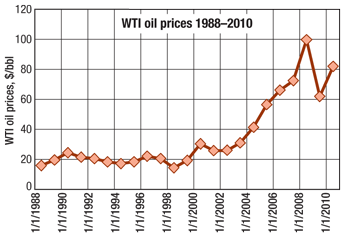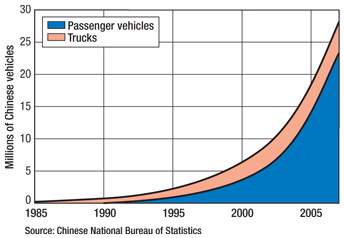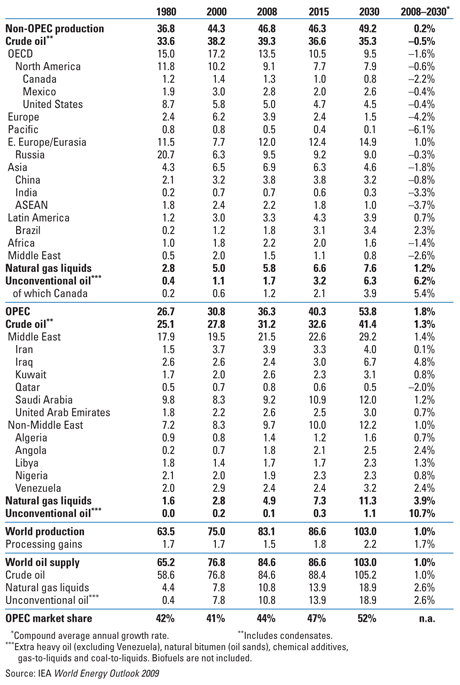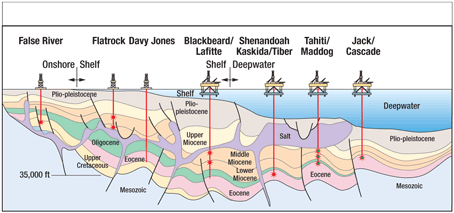Why focusing on how to predict and mitigate future pitfalls
may be just as important as learning from our past mistakes.
Matthew R. Simmons, Simmons & Company International, Houston
This past year turned out to be an ironic and bittersweet end to what was arguably the most important decade our global oil markets have ever experienced. Throughout the first 10 years of the 21st century, the world’s largest industry dealt with one surprise after another. Ranging from a staggering and entirely unplanned increase in global demand to a steady decrease in the number of new significant oil finds, observable declines took place in almost every key oil field around the world. These declines also included many relatively new fields that were designed to produce at unrealistically high flowrates, then expected to remain at those levels for several years. Furthermore, there were strong signs that global crude flows had probably reached their highest sustainable flowrates back in 2005. As the decade progressed, the number of surprises grew. All of this was reflected in a wild rollercoaster of oil price volatility.
At the beginning of 2009, oil prices hovered just above $30 after plummeting in the last three months of 2008 by the largest percentage decline ever recorded. In February 2009’s World Oil, I raised several very important questions that our oil markets would face. Most importantly, I questioned whether the new price collapse in the fall of 2008 would be as short-lived as other price collapses seen over the prior 10 years, or whether oil prices would stay low for a prolonged time. I also questioned how detrimental the impact of $30 oil would be on new supply projects and how low oil prices would affect the twin cancers plaguing the industry: rusting assets and an aging workforce. These inquiries led to one big overarching question: How rapidly would oil demand bounce back and begin growing again once global economies were stabilized?
By the end of 2009, we had concrete answers to all of these questions. Oil prices rebounded more quickly than they had after any prior collapse. The sharp rise proved to be far more sustainable than most oil pundits thought back in mid-February 2009, when prices quickly soared after spending three months around the $30/bbl range. In just four additional months, oil prices were back in a mid-$50 to low $60 price range, and it took only another four months before oil was once again knocking at the $80 door—a scenario few oil observers would have thought remotely possible at the beginning of the year.
 |
|
Fig. 1. The daily price of West Texas Intermediate (WTI) crude oil from 1988 through the present (recorded semi-annually).
|
|
As 2009 came to a close, oil prices had risen by 89% from the beginning of the year, the highest-ever recorded annual price increase. During the first month of 2010, NYMEX West Texas Intermediate oil prices finally broke the $80 “ceiling,” due to some astonishing strong economic news pouring out of China and, in part, to near-record cold weather throughout most of the Northern Hemisphere, Fig. 1. It seemed as if we had finally reached the calm after the storm.
What was deemed by almost every serious economist to be the world’s worst recession since the Great Depression, 2009 now shows every sign of having one of the fastest recoveries in recent history, thanks to aggressive government stimulus funding in the US, China and many other countries. As the year came to an end, surprisingly positive data emerged on the strength of our financial and energy markets, just as most economies around the world were starting to experience encouraging news of stronger and, hopefully, enduring economic recoveries.
The most important oil story of 2009 was that of China’s growing and insatiable appetite for oil. This was certainly not new information, as perhaps the biggest change in our world oil markets since the end of World War II has been the “China Story.” For the past 15 years, China has rapidly emerged as one of the world’s largest and strongest economies, becoming a poster child for what is happening in previously underdeveloped nations. Remarkably, as the miracle of China’s emergence as an economic superpower grew by leaps and bounds, many of the world’s renowned energy economists shrugged off this growth as abnormal and constantly predicted a hard landing for China.
I never doubted the “China Story.” After returning from a 20-day visit I made to China in April 1997, I spent a great deal of time absorbing every bit of economic data on what was really unfolding in China. By the fall of 1997, I issued a lengthy paper titled China’s Insatiable Energy Needs. Anyone visiting China between 1997 and 2006 could easily recognize the development underway there as the fastest growth in a massive economy since America emerged from World War II as a world-class superpower. I was not in the least surprised that China’s oil use doubled in less than 10 years: my 1997 white paper predicted this would occur.
The question currently at hand is whether China will be able to slow down its growth, given the uncertainty of whether there is enough oil or other key natural resources to sustain the rapid global economic growth. While the topic has been heavily debated, no one has presented a feasible way for China’s leaders to slow, let alone stop, the growth pattern that the world’s largest country is now experiencing. China’s insatiable growth in oil demand is reflected in its steep rise in automobile ownership, Fig. 2.
 |
|
Fig. 2. Automobile ownership in China from 1985 through 2007.
|
|
This emerging economic phenomenon is not a story limited to China alone; India lurks quietly in China’s shadow, as do Brazil, parts of the Middle East and most of the rest of Asia.
What is almost mind-boggling about this surge in world oil demand is that these emerging strong-growth markets have a combined population that now represents almost half the globe and could grow by an additional one billion people or more over the next decade.
To put all of this in some historical context, when I first began writing my annual World Oil outlook article in 1992, the OECD, with less than one-sixth of the world’s population, still accounted for almost two-thirds of global oil demand. In 2010, non-OECD oil demand will be closing in on parity with OECD oil use. Within a few more years, non-OECD oil demand will begin to outstrip OECD’s oil use.
It seems clear, with the wonderful benefit of hindsight, that the oil markets were far too pessimistic about how fast oil demand was falling. It is now not even clear how badly short-term demand really fell on a global basis. It will take another six months before there is preliminary data for 2009 global, or even US, oil demand. At the worst, demand fell far less than almost anyone estimated as recently as a year ago.
A far more important issue is how our oil markets will supply any further significant demand growth. The International Energy Agency’s (IEA’s) World Energy Outlook 2009, published in November 2009, candidly addressed the challenges the world faces in meeting even a modest growth in oil demand. The IEA’s 2009 outlook re-emphasized its oil supply forecast issued a year earlier: “To simply keep oil demand flat between now and 2030, a mere two decades away, the world would need to add the oil output equivalent of four new Saudi Arabias. To grow global demand only modestly, versus all the old long-term demand models, we would need to add two more Saudi Arabias.” What the IEA leadership left unsaid was how unlikely even adding the equivalent of four Saudi Arabias would be. The real answer is “virtually impossible.” The most powerful graphic of how fast current mature crude production is falling is depicted in the IEA’s production forecast, Table 1.
If oil demand turned out to be harder to slow down than almost everyone believed a year ago, supplies turned out to be even more restricted than they appeared as I wrote my February 2009 World Oil article. While there has been much excitement about the series of new super-giant oil fields discovered in Brazil’s Santos Basin and a slew of possible new deepwater fields in the Gulf of Mexico’s Lower Tertiary, none of these new fields has had adequate appraisal wells carefully tested to really know whether it is really commercial. The grim reality of both exciting new regions is that it will take a long time and a lot of capital to obtain accurate data before anyone knows how much oil can be produced from them.
| TABLE 1. Crude oil production (millions of barrels per day) by region, according to IEA |
 |
Just recently, the giant Davy Jones prospect was discovered in the Gulf of Mexico’s shallow waters. But, the hopeful gas reserves in Davy Jones are at vertical depths of over five miles, Fig. 3. It will take 10 more wells costing $150–$200 million each to learn the real extent of this field. Moreover, only through lengthy flow tests will the operators know what this new find might yield in producible natural gas.
 |
|
Fig. 3. Cross-section of various wells in the Gulf of Mexico, indicating varied vertical depths and geological formations.
|
|
It is easy for oil observers to read about the discovery of a few-billion-barrel oil field and assume this will soon turn into flowing oil. The reality of finding oil, however, is still the same as it was decades ago. One or even two exploration wells in an untested structure cannot accurately be measured for true proved reserves. To really be able to grasp the amount of recoverable oil in a new wildcat field, many appraisal wells throughout the structure need to be not only drilled, but also core tested and then subjected to lengthy flow tests. Only through these time-tested measures can any company accurately assess the total size of a potential oil-bearing structure, not to mention the quality and consistency of the reservoir rocks and the flow qualities of the crude produced.
Over the past decade or so, many economic mistakes were made in developing deepwater fields that were designed to produce, on average, almost twice as much as eventual peak flows. In most cases, the peak only lasted a matter of months before declines of 20–35% set in. These errors were almost all due to the lack of adequate solid data on the fields’ productivity and the rate at which decline sets in.
As our oil markets begin a new year, the data is far more convincing that global crude oil flows reached their sustainable peak output in 2005. Visible and non-reversible declines in Mexico, the North Sea and many other key oil producing areas have now created such a gap between 2005 record flows and the present that it is hard to create a credible scenario to fill these gaps back up. Yet the issue of peak oil remains highly controversial, and too many seemingly educated oil observers still think the meaning of “peak oil” is that the world is running out of oil. The meaning of peak oil is the time when the world has reached its maximum rate of oil extraction, after which production declines set in.
The world has already seen a serious shrinkage in the flow of light, sweet crude grades. Most of what were once large flows have now slowed to mere trickles. Taking the place of high-quality sweet oil are heavier crude grades that are also far sourer and often laden with toxic metals and other undesirable properties. The challenges this change in crude quality flow poses to our global refinery system is yet another unaddressed problem to tackle as we enter the second decade of the 21st century.
Over the last year, the global system also did nothing to address what I described last year as the twin cancers invading the industry’s sustainability: rusting assets and an aging workforce. Instead, both issues worsened at a time when they should have been tackled head-on. The oil industry must develop a gameplan to replace a sizeable portion of the infrastructure and begin hiring and training a new workforce. This lack of action might be the lasting ugly legacy of the 2008–2009 oil price collapse, with time becoming the oil industry’s enemy in its battle to conquer rust and an aging workforce. Time, time, time is now no longer on our side.
The oil industry is the largest industry in the world, and its importance to the world’s well-being cannot be over-exaggerated. Yet, for an industry so large and important, it is amazing that so little is known about the real costs to develop the next generation of oil fields, assuming there is even a real population of new oil fields to commercialize and produce. The oil industry has not a single credible blueprint on how to attack its chronic rust problems, not to mention a fair estimate of how much this would cost. Not a single model has been created to even predict the number of new drilling rigs and the armada of other support equipment needed to simply replace the existing core, let alone replace an expanded armada to perform far more extensive appraisal testing and coring of each new well.
Additionally, no one has addressed the water issues that are vital to sustaining our oil system. Until earlier this year, I had never seen any data on the amount of water that needs to flow through the cooling towers of a refinery to turn crude into usable finished products. I found it amazing that a 300,000-bpd refinery uses about 21 million gallons of water a day.
Little data has ever been laid out on the water intensity required to sustain reservoir pressures in places like Saudi Arabia or to rehabilitate Iraq’s oil system. There is scant data on the brine brought to the surface by US stripper wells, let alone the energy costs involved with the disposal of this brine (although some credible studies suggest America might be disposing up to 130 million bbl a day of brine). I suspect few oil experts have ever attempted to look into how much water is needed to create our crude flows, let alone the refining of crude into usable finished products.
There is also almost no good data on the amount of potable water used to create flowing oil from Canada’s oil and tar sands or to turn heavy oil in California’s Kern County into slow-flowing crude through massive steam soaks. Even worse, over the years, the oil industry has used this water at little or no cost. As concerns about water scarcity rise, the costs of using water in the oil field will soon begin to change. Once oil and gas participants are forced to begin paying a fair price for the water they use, there will be a stunning impact on the need to price oil and gas at far higher prices.
As a growing number of key world organizations begin to address the likely clash of the world’s insatiable appetite for water and the large regions of our global population with no current access to potable water, the likelihood that the world will begin to demand far more charges for those using most of our water will be high. This could be another major hidden tax on the cost to sustain our oil flows.
Sooner or later, the world needs to hold an oil summit equal to the recent Copenhagen Summit for climate change, to begin addressing oil issues. We need to discuss how we will curb the world’s growth in oil demand, how we will begin a transition from our high reliance on the use of petroleum as our only viable transportation fuel, and the cost of ensuring that even a slowing global flow can be sustained. If such a conference were convened and the issues properly addressed, I suspect it would highlight how dangerous ever-higher price volatility really is and how cheap even $150/bbl or $100/bbl probably will be as we begin facing the challenges of a post-peak oil world. In my opinion, oil prices ultimately need to rise far higher and then remain at those levels to begin unlocking a way of coping with less oil supply than we need. Additionally, the world needs to focus on creating a genuine substitute for fossil fuels that scales and is sustainable.
In hindsight, many (or even most) of our astute oil pundits were worried about the wrong things. As a group, they were the generals planning how to re-fight the last war. For the past decade, conventional energy wisdom has constantly suspected that oil demand growth was an aberration, instead of recognizing a very real emerging trend toward prosperity. The long, relentless and steady rise in oil prices was also misread and badly misunderstood when oil prices periodically plummeted. The fall was cheered by too many supposed experts as good for the industry and the global economy, rather than being seen as a cruel hoax to oil consumers, convincing them that low oil prices were still a permanent feature of our oil markets.
There is no hard data issued by any credible source that begins to realistically fathom what constitutes a fair price for oil, taking into consideration that the delivery system needs to be rebuilt, or a price that begins to create even the vaguest sense of shared economic prosperity in too many of our key oil producing countries. Nor is there any data to show how a far higher price for oil might facilitate a transition to a world with far less high-quality oil to consume. Too many oil authorities, who ought to know better, simply respond that “oil needs to stay cheap so consumers can afford to use it and we keep alternate competing fuels from stealing oil’s rightful market share.”
Last fall marked the 150th anniversary of Colonel Drake’s discovery of oil in western Pennsylvania. Arguably, this ushered in the greatest miracle and wealth creator in world history. By the turn of the millennium, oil’s use had grown from lamp oil, Vaseline and Maybelline mascara to the world’s sole energy source for transportation. Today, almost one billion vehicles travel the world using almost 30 million bbl a day of finished petroleum products. Millions of planes traverse our skies, and military forces rely on oil to keep the world safe.
As our oil markets enter the second decade of the 21st century, we are reminded that we have come a long way from where we were when the 20th century came to a close. Just 10 years ago, the world was worried that a return of the Asian flu would threaten to stop further growth in the Asian economies and spread to many other parts of the world. We were consumed with great fear as the world approached the Millennium of Y2K. We responded by immobilizing our computer systems and preparing for the possibility of planes falling out of the sky as Dec. 31, 1999, turned into 2000. We have also come a long way from all the fears of a pending non-OPEC supply glut being just around the quarterly supply report corner.
If I could have a single wish granted for the betterment of our global oil markets, it would be that, in 2010, key oil industry stakeholders would finally raise their collective voices and begin demanding genuine transparency on actual production from all key oil fields. If the world continues resting on the complacency of verbal assurances from oil ministers in key producing countries with no genuine data to back these claims, then we will increase the risk that our oil markets face. We could risk a similar (but far more economically devastating) fate as the one our financial systems suffered because of the lack of transparency from key financial players like AIG, Lehman Brothers, Freddie Mac and Fannie Mae, etc. By not insisting on 100% transparency in our key oilfield flows, we risk jeopardizing the quality of the remaining oil to be extracted. It is time to “trust but verify,” as Ronald Reagan advocated during the Cold War.
Let me close with my personal New Year’s wish for our global oil system. I hope our oil leaders set a New Year’s resolution to turn a new page and begin addressing the real and difficult problems that face our oil markets in 2010. How terrific it would be to write the 2011 outlook article, marking 2010 as the beginning of true enlightenment in our oil markets. 
|
THE AUTHOR
|
|
|
Matthew R. Simmons, Chairman Emeritus of Simmons & Company International, graduated cum laude from the University of Utah and received an MBA with distinction from Harvard Business School in 1967. He served on the faculty of Harvard Business School as a research associate for two years and was a doctoral candidate. He began a tiny energy investment bank 40 years ago, which he later established as Simmons & Company International when he moved to Houston in 1974. The firm has played a leading role in assisting energy client companies in executing a wide range of financial transactions. He serves on the boards of several industry and civic groups and art institutions. In 2007, he founded the Ocean Energy Institute in Rockport, Maine. Mr. Simmons is past chairman of the National Ocean Industries Association. He serves on the board of the Deans’ Advisors at Harvard Business School and is past president of the Harvard Business School Alumni Association.
|
|
|







